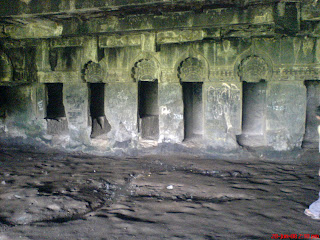After buying ur eatables, just walk out of the station and get to Shri Ram Pur which is at a walking distance or can take a rickshaw which may charge you 15rs.
Ten seater rickshaw (Dukar Rickshaw) on share basis 10rs per seat to Kondivade which is 10 kms from karjat Shri Ram Pur
you can even hire ten seater Dukar rickshaw for you in 100rs till Kondivade or Kondane for 150rs.
From Kondivade you will have to walking to kondane it is around 30-45mins walk but it is very beautiful and picturesque as seen in the photographs. There is Ulhas river flowing along side the road so you even enjoy that.


The trek will start when u reach the kondane base there are a few houses in there so u can even ask them for directions.Once u start ascending for kondane caves there will be grasslands and slope on which u would do the trekking. The trekking is on the way of water flowing down the hill, that's the reason its a bit marshy and very slippery at times so be careful while trekking.
 After trekking for a hour or so there is a waterfall on the way you can have a break there and enjoy the waterfall there.
After trekking for a hour or so there is a waterfall on the way you can have a break there and enjoy the waterfall there.
Now once you have reached till waterfall there is only half a hour trekking remaining.

Over the head of the figure, at the level of the spring of the great front arch, is a broad outstanding belt of sculpture. The lower portion of this belt is carved with the rail pattern; the central portion is divided into seven compartments, three of them filled with a lattice pattern, and four with human figures, a man in the first, a man and woman in the third and fifth, and a man with a bow and two women in the seventh. Over these com-partments is a band with the representations of the end of tie-beams or bars passing through it, and then four fillets, each standing out over the one below, and the upper half of the last serrated. The corresponding belt of carving on the right side of the front is much damaged by the falling of the rock at the end next the arch.

A little to the north-east is Cave II, a monastery or vihara, whose veranda front, except the left end, is totally destroyed. This veranda was five feet eight inches wide and eighteen feet long, with five octagonal pillars and two pilasters. In the end of this verandah is a raised recess, and under a horse-shoe arch is a small relic shrine in half relief, apparently the only object of worship. Inside, the hall is twenty-three feet wide by twenty-nine deep and eight feet three inches high, with fifteen pillars arranged about three feet apart and 31/2 feet from the side and back walls, but none across the front. The upper portions of these pillars are square, but about ½ feet from the top they are octagonal; the bases which were probably square have also gone. In imitation of a built hall the roof is panelled with beams, nine-teen inches deep by eight thick and 3½feet apart, which run through the heads of the pillars, the spaces between the beams being divided by false rafters, five inches broad by two deep. Though most of the front wall is broken, there are three wide doors into the hall, and on each side six cells, eighteen in all, each with a monk's bed and the first on each side with two beds. Over the doors of fourteen of these cells are carved horse-shoe arches, joined by a string course which stands out six or seven inches and is ornamented with the rail pattern. Cave III is a plain monastery six yards square with nine much ruined cells. It probably had three doors. Cave IV is a row of nine cells at the back of what now looks like a natural hollow under the cliff. Beyond them is a cistern, now filled with mud, then two cells under a deep ledge of overhanging rock, and, lastly, a small cistern. Most of the caves are now in very bad repair and the inscriptions have been erased so as to make them illegible. The caves are now in charge of the Archaeological department of the Government of Maharastra and are often visited by student parties.
There is a waterfall also there. Go get soaked in that, it would be very refreshing and you would be rejuvenated.
As you would have seen the caves they can even serve as changing rooms.
So you can even involve ladies in your trek.
After changing the clothes and stuff, we had our lunch there. When we had been there was a person who was selling tea and roasted corn (Bhutta). We started descending the hill after our lunch.
It was one of the most memorable trek I have ever been to.
There are groups who organize trekking, rappelling. Now we have decicded the next destination would be Rajmachi Fort. Lets see when we reach there.
Please leave your comments after reading this.
Thank you,
Rishi
